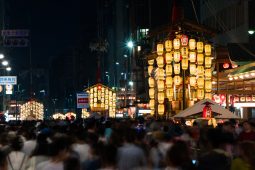When I take visitors from abroad to a festival in Japan, or just tell them about it (which is often, since they’re the entire country’s major and constant attraction from about May till September), I’m always careful to call it a festival and not a holiday. ‘Holiday’ runs the risk of coming across as something that’s handled with the same sort of gravity that might be given to, for example, Easter or Passover in some communities; yes, these festivals are often important and significant, but they don’t really carry the kind of seriousness that a westerner, in particular, might expect. ‘Carnival’ might give a better idea of what kind of atmosphere to expect, but otherwise, it’s completely off the mark, so ‘festival’ it is. Some of you might have seen Japanese summer festivals depicted in media, but even that doesn’t usually catch the raw energy of it all. If you’re in Japan, visit one some time; my small city has seven major festivals that I can think of from July to September alone, so it’s easily done. Otherwise, a video of any one major festival might give you a good idea.
While we’re here, though, let’s take a look at an example only half an hour away from me: The Itoigawa city Kenka Matsuri (lit. ‘fight festival’). There are at least twenty festivals by that name throughout Japan, and the only common thread is that they’re even louder and more raucous than most summer festivals (also, nobody actually fights). This one, though, has an unbeaten record of stunning everyone introduced to it.
When you arrive, you’ll find that the shrine grounds and surrounding park look more like a crowded marketplace. This, at least, is just like any other festival. Every bit of spare roadside space is lined with stalls for foods (get some or you’re missing out, just make sure someone local can tell you what’s in it), games of chance for the children in the crowd, and in a bit of an odd tradition, a game of chance where the prize is as many goldfish as you can scoop out of a basin with a paper scoop. That last one tends to end exactly how you would expect, almost before you start.
Food in hand, you might wander around through the grounds and the (modest, in a small city like this) crowd to find a spot with a combination of a good view and some shade from the summer heat. At a larger festival, you would probably have a taiko drum band on the premises at least some of the time, parades with giant dashi (floats) rolling through the streets, and a fireworks display to cap it all off. This, on the other hand, is a smaller kind of festival.
After a while, two teams – about a dozen men each – step out from behind the shrine. Each of them is carrying a mikoshi, a kind of palanquin meant to hold (at least symbolically) the shrine’s god, or one of several. Carrying gigantic palanquins around the town, chanting and shouting the entire time, is one of the most common parts of any summer or autumn festival, so it might not get much of a reaction yet from experienced festival-goers. Dozens of people running around shouting and hauling miniature, lavishly decorated wood-and-metal shrines, after all, is nothing that unusual.
Japan does things to your standards sometimes, it’s true, but I couldn’t be happier for it.
A few minutes later, the action starts. Palanquins lifted high – and I really can’t overstate the weight of these – the two teams start chasing each other in circles around the shrine at breakneck speeds, running around and around for several laps. Then suddenly, they stop. The shrine’s head priest steps between the two groups (which, by the way, are from two local communities by way of a bit of friendly competition), and briefly breaks them up. Once he backs away, the two teams move again.
This time, they face each other, and ram the palanquins into each other, as the day’s real attraction starts: The two teams smash their palanquins together in what I can only describe as shrine wrestling, bringing them together like a pair of battering rams while the crowd cheers them on. I was never completely clear on the rules, but as far as I can tell, a round is won when one palanquin is either forced to the ground or has pieces broken off it. This goes on until dark, surrounded by cheering, shouting, and occasionally music.
It’s a one-of-a-kind experience, but only because bashing shrines together in particular is a rarity in Japan; otherwise, it’s a relatively small, quiet festival, which is exactly why I think everyone should see this kind of event for themselves: You probably won’t see anything else quite like it, especially coming from a western background. If you’re going to be in Japan, why not see the things no other place could offer when they’re this easy to find?
Next time, I’ll be introducing Japanese firework displays, and everything you need to know to make the most of them; just like every other kind of festival (and often on the same night), it’s almost harder not to bump into one in a Japanese summer, so you’ll have more than enough chances to put it to use!








